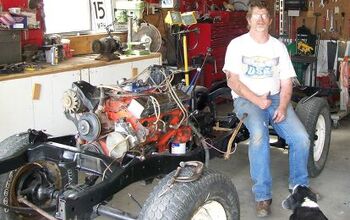How To Sell Your Car
The time has come. After oh so many years of driving the same old beater, it’s finally time for you to pass the torch to the next owner.
God help them.
Step 1: Clean the big things first.
The first step in getting the most money out of your car is remembering that virtually no one wants your mementos. Big or small. Even those who buy an oldie of a work truck want their battle scarred warrior to look as new as possible.
It comes down to this. If you clean it, they will pay. If not, they will gripe.
Start with the inside. You may have some work ahead of you!
And when we say the inside… we also mean the glovebox, trunk, door panels, and any other crevice where you may store your stuff. Even the ashtray if your ride still has one. Even the area under the carpet of the trunk.
All those papers, bags, leftover food wrappers, refuse from another era, and ‘personal stuff’ need to be out pronto. Nobody wants them. Not even your pet.
Start with the big things inside and work your way down to the smallest of crumbs.
Step 2: Clean the small things second, and look through everything twice.
Once your hands fail, use a vacuum. Remember to remove the floormats while you clean the interior of the car.
Now check those floormats for a quick second. Are they still intact with perhaps a few random stains? Or has your shoe or boot created a gaping hole? If you created a hole, or just wore it out after all these years, you’re in luck! A good looking set of floormats is usually only around $25 to $35. Buy em’.
Even the chintziest of professional car dealers will invest in floormats so that they can realize a retail price.
Once you finished vacuuming the car , use a stain remover and an interior detail cleaner. Make sure to read the instructions so that you avoid using anything that may stick or stain.
One big word of caution here. If it has bleach, don’t use it. Ever. Go to an automotive forum that specializes in your model if you want to read up before you buy.
Step 3: You don’t use bumper stickers on your car now… do you?
Nothing says ‘crappy old car’ quite like a large assortment of bumper stickers on the rear. If you have one or two, go forth and buy a can of Goof Off for all your past pearls of wisdom.
If the car is afflicted with the bumper sticker virus, then just let it be. Schmuck!
Step 4: Wash first. Wax later if needed.
Some folks want to invest in a cheap $5 car wash, and let that be that. Others consider an afternoon cleaning their motorized chariot as a great way to spend their free time. Figure out the type of person you are and go from there.
If the car has large dull patches where the wax has completely worn off, you need to wax it. You have two choices. Do it yourself. Or hire a professional.
Most owners are better off opting for the second choice if they haven’t done it themselves in a long, long time. Don’t rely on online reviews. Instead, go to the place yourself first and judge whether you would be satisfied with the finished product.
Some mobile detailers are good at what they do. However I would strongly encourage you to ask people you know before going that route.
Step 5: Gather the paperwork.
A stack of records is not only worth a thousand words. It’s often worth a thousand dollars, and sometimes even more.
Go ahead and bring them all together. If you are missing a few, call the places where you had your work done and see if they can print you another copy.
Collect all your maintenance records and sort them in chronological order. You now have a good story to tell.
Step 6: Nutjobs get the most money
The people who get the most money for their ride are usually those who have been the most manic about maintenance, upkeep, and the car in general.
Become one. Consider the stark differences between the answer to the following question,
“When was the last time you got the oil changed?”
Seller 1: “Six months ago.”
Seller 2: “I always changed it every six months or 5,000 miles. It takes 3.6 quarts of Mobil 1 and an AC Delco filter. I use a 12mm to remove the oil drain plug and I never, ever go to those Quickie Lube places. This is my car and I do it myself.”
Now keep in mind seller two said quite a bit. The first two sentences are fine. But when it comes to selling any car, details offer more assurance than anything.
The more details you can provide. The more you will get.
Step 7: Common cars often sell better locally. Rare car + not old = Ebay
As a local car dealer, Craigslist and Autotrader have been my bread and butter for a long time.
This is in addition to several online communities that specialize in a particular brand, along with sites that focus squarely on the local community. Most of those sites have a ‘city’.com or ‘county’.com format.
However you may get surprising dividends by posting your car at a bulletin board at a school, your local community center, or your place of worship. Please make sure they know you before you just show up. Otherwise you may wind up chased, shot, asked to play racquetball, or proselytized.
One other thing. This may be a good time to use Facebook. You may also want to also inform your older friends or relatives who haven’t quite yet embraced the latest social websites. You would be surpsied how many cars sell thanks to a ‘friend of a friend’.
Step 8: When advertising your car, close ups and good stories are better than distance photos and cliches.
Craigslist allows 8 pictures. Ebay provides slots for 24 photos if you use their template.
Autotrader has a variety of offerings with their 9 picture / 4 week deal being the most common one.
My advice is to get at least five close-ups along with three distance shots if you plan on selling via Craigslist.
Three good distance shots: Front , side view, and rear.
Three close-up interior shots: One dashboard view from behind the driver seat. One close-up of the driver seat. One well kept part of the car in sound cosmetic shape (dashboard wood, door panel, shifter, etc).
Two close-up exterior photos: Close up of front grille, tire/alloy wheel, driver door, emblem or similar item that is unique to that car.
As for words… tell them everything and make your ad genuine. Don’t read other ads because 90+% of them stink to high heaven with the same gibberish terms. Tell your story and sound like yourself.
Step 9: Meeting and greeting
Some folks are comfortable having a stranger on their driveway. Others only like to meet in popular places where video cameras are plentiful.
Figure out which scenario works best for you. Along with that, remember you are selling the vehicle AS/IS. This means that once they pay for it, done. You have no responsibility other than providing them with a clear title and the keys.
As for those keys, don’t have them out once you meet them. Figure out first if you may have a good reason NOT to give them the keys. Always ask for a Drivers License once they ask to drive your car, and make sure the key chain you give them only has keys to the car… not your home or business.
Step 10: Payment and paperwork
So they want to buy it? Congrats! Now cover your bases.
There are a LOT of scam artists out there. You want to use an AS/IS contract like this one and ask for the buyer’s drivers license so that you can fill out the information correctly on the bill of sale and title.
Sometimes addresses are not current. So you should ask if they still live at that address as well. When it comes time for you to fill the bill of sale out, make sure you are the only one filling it out. In fact, it’s usually best off to have everything done beforehand with the exception of the buyer’s information. You don’t want any unauthorized alteration to be done with the contract after the fact.
If you are not comfortable handling large sums of cash, or want to have a certified check verified, the bank is always the best place to do it. Sometimes the banks are closed though. If that happens, have someone with you and/or go to a place that has a video camera to monitor activities. The local diner or chain restaurant will usually have a video camera up and running.
Payment Note: Don’t take personal checks. Don’t take money orders, and don’t take certified checks from banks that either you have never heard of or those that are out of state. Cash and certified checks from familiar in-state institutions are usually fine.
Every certified check should have some type of watermark or unusual labeling to ward off counterfeiters. If you don’t see it or just feel uneasy, ask if they can meet you at the bank to verify the check, and offer them a refundable deposit to hold the car until that meeting.
Once the vehicle is paid for take care of the back of the title. Have them sign the title as the buyer in your presence, and make sure you sign off on the title as well.
Curbstoners will usually not sign the title as the buyer and then try to sell the car by pretending to be you. You don’t want that.
I hope you enjoy what will hopefully be a four figure return over the trade-in value.
But if all this sounds like a pain, that’s fine too. You now have extra incentive to keep that daily driver until it’s worth more dead than alive. All the best!
More by Steven Lang
Latest Car Reviews
Read moreLatest Product Reviews
Read moreRecent Comments
- Jalop1991 In a manner similar to PHEV being the correct answer, I declare RPVs to be the correct answer here.We're doing it with certain aircraft; why not with cars on the ground, using hardware and tools like Telsa's "FSD" or GM's "SuperCruise" as the base?Take the local Uber driver out of the car, and put him in a professional centralized environment from where he drives me around. The system and the individual car can have awareness as well as gates, but he's responsible for the driving.Put the tech into my car, and let me buy it as needed. I need someone else to drive me home; hit the button and voila, I've hired a driver for the moment. I don't want to drive 11 hours to my vacation spot; hire the remote pilot for that. When I get there, I have my car and he's still at his normal location, piloting cars for other people.The system would allow for driver rest period, like what's required for truckers, so I might end up with multiple people driving me to the coast. I don't care. And they don't have to be physically with me, therefore they can be way cheaper.Charge taxi-type per-mile rates. For long drives, offer per-trip rates. Offer subscriptions, including miles/hours. Whatever.(And for grins, dress the remote pilots all as Johnnie.)Start this out with big rigs. Take the trucker away from the long haul driving, and let him be there for emergencies and the short haul parts of the trip.And in a manner similar to PHEVs being discredited, I fully expect to be razzed for this brilliant idea (not unlike how Alan Kay wasn't recognized until many many years later for his Dynabook vision).
- B-BodyBuick84 Not afraid of AV's as I highly doubt they will ever be %100 viable for our roads. Stop-and-go downtown city or rush hour highway traffic? I can see that, but otherwise there's simply too many variables. Bad weather conditions, faded road lines or markings, reflective surfaces with glare, etc. There's also the issue of cultural norms. About a decade ago there was actually an online test called 'The Morality Machine' one could do online where you were in control of an AV and choose what action to take when a crash was inevitable. I think something like 2.5 million people across the world participated? For example, do you hit and most likely kill the elderly couple strolling across the crosswalk or crash the vehicle into a cement barrier and almost certainly cause the death of the vehicle occupants? What if it's a parent and child? In N. America 98% of people choose to hit the elderly couple and save themselves while in Asia, the exact opposite happened where 98% choose to hit the parent and child. Why? Cultural differences. Asia puts a lot of emphasis on respecting their elderly while N. America has a culture of 'save/ protect the children'. Are these AV's going to respect that culture? Is a VW Jetta or Buick Envision AV going to have different programming depending on whether it's sold in Canada or Taiwan? how's that going to effect legislation and legal battles when a crash inevitibly does happen? These are the true barriers to mass AV adoption, and in the 10 years since that test came out, there has been zero answers or progress on this matter. So no, I'm not afraid of AV's simply because with the exception of a few specific situations, most avenues are going to prove to be a dead-end for automakers.
- Mike Bradley Autonomous cars were developed in Silicon Valley. For new products there, the standard business plan is to put a barely-functioning product on the market right away and wait for the early-adopter customers to find the flaws. That's exactly what's happened. Detroit's plan is pretty much the opposite, but Detroit isn't developing this product. That's why dealers, for instance, haven't been trained in the cars.
- Dartman https://apnews.com/article/artificial-intelligence-fighter-jets-air-force-6a1100c96a73ca9b7f41cbd6a2753fdaAutonomous/Ai is here now. The question is implementation and acceptance.
- FreedMike If Dodge were smart - and I don't think they are - they'd spend their money refreshing and reworking the Durango (which I think is entering model year 3,221), versus going down the same "stuff 'em full of motor and give 'em cool new paint options" path. That's the approach they used with the Charger and Challenger, and both those models are dead. The Durango is still a strong product in a strong market; why not keep it fresher?











































Comments
Join the conversation
I didn't know that about AAA. That's a great idea. This is just nitpicky and I doubt anyone here does this...but take all pimp accessories off or out of the car before you sell it. Yes, I'm sure your Buick Century is lovely but I can't see beyond the gigantic snowflake rims and ground effects. Same goes for political stickers and anything that declares your love for cats/dogs/fat chicks/Dave Matthews Band.
Your article is very detailed and it helped me to understand the whole process. Last month i was in Dubai and had to sell my car on urgent bases. I Google it and found a website uae.sellanycar.com who purchased cars online. I send them my car details and guess what? they purchased my cars in just 30 minutes. They handeld all the documenations and send me the cash right away. But while transaction and car valuation i keep your tips in mind and it helped me alot to understand the important notes.